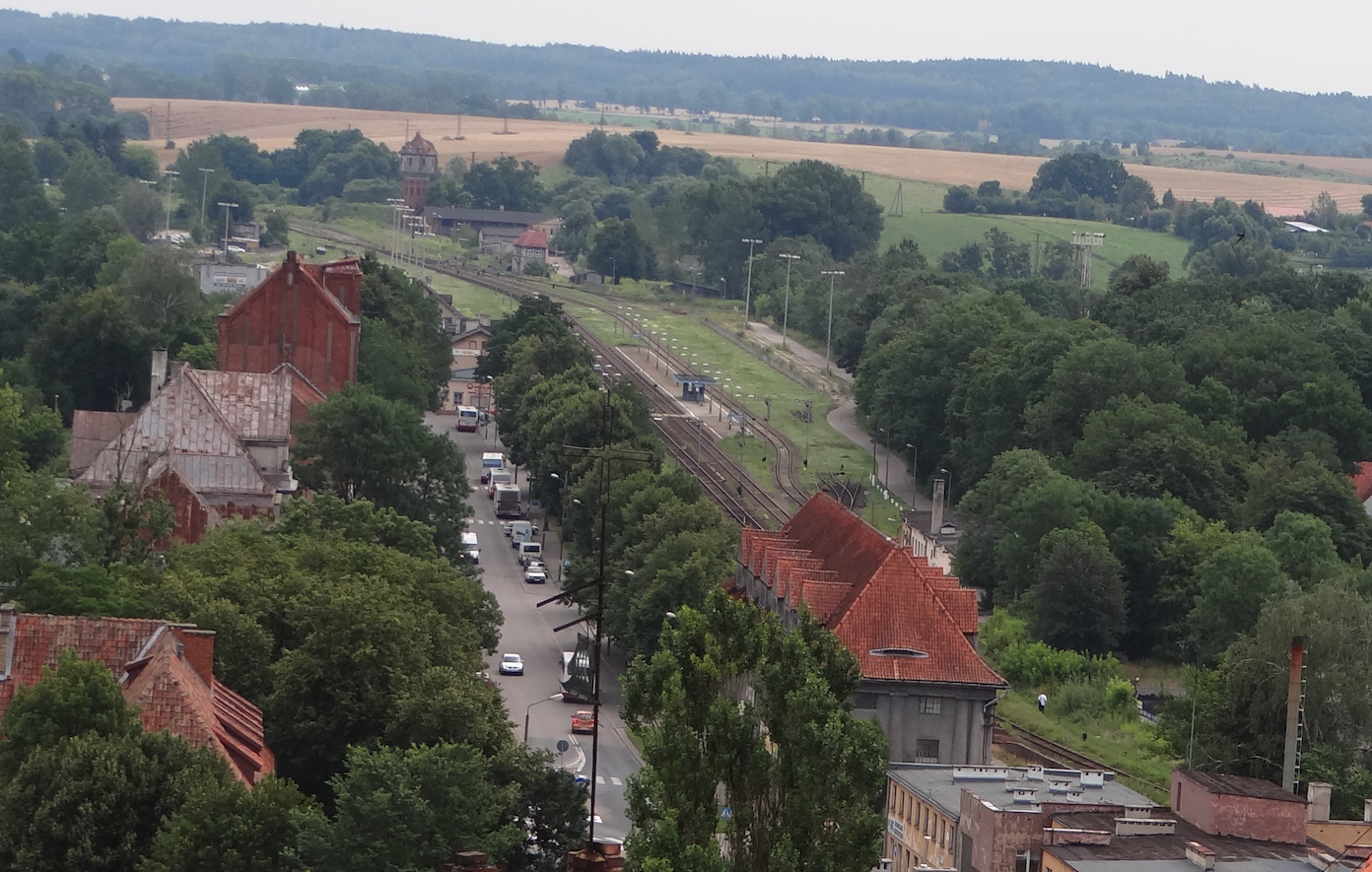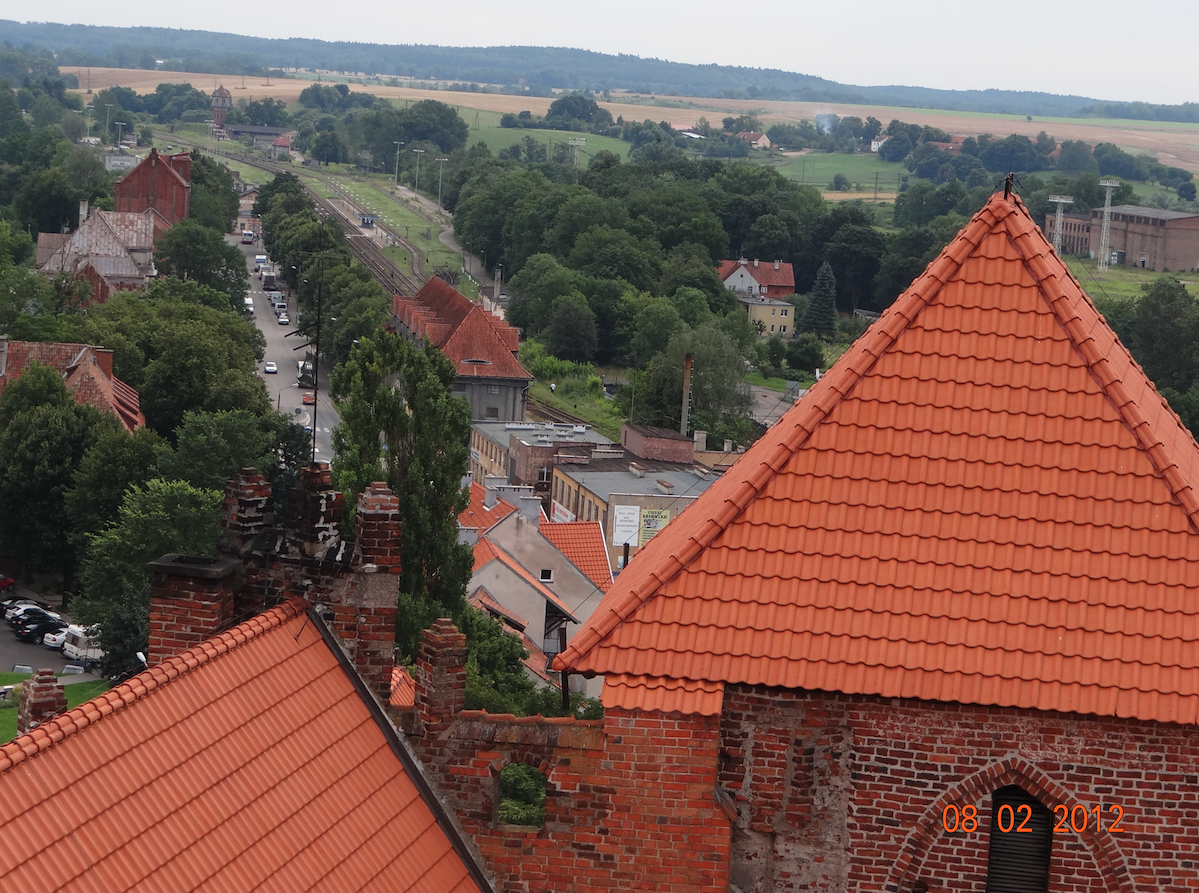Kętrzyn 2022-09-29
Railway station in Kętrzyn.
Geographic coordinates: 54.072N 21.386E.


Description of the photo: The photo was taken from St. George's Basilica in Kętrzyn.

Description of the photo: The photo was taken in the museum named after Wojciech Kętrzyński at the castle in Kętrzyn. The photo from 1937 shows the St. George's Basilica, the prince's castle and the railroad tracks from the Sątopy-Samulewo station and the Korsze station.
The city of Kętrzyn.
It is a city in Poland in the Warmian-Masurian Voivodeship and is the seat of the Kętrzyn District. Historically, Kętrzyn is located in Prussia, and geographically in Masuria, it is exactly the Mrągowo Lake District.
In 2016, Ketrzyn had 27,629 inhabitants. The city covers an area of 10.34 square km. The average height above sea level is 100 m.
In the 13th century, the lands where the settlement was located were seized by the Teutonic Order and included in the Teutonic State. The city was founded in 1329, and in 1357, it was granted a location on the Chełmno Law. In 1375, the borders between the Teutonic Order and Prussia were established, and Kętrzyn was incorporated into Lower Prussia. During this period, the construction of the castle was completed and the city was surrounded by a wall with 13 towers. There were two gates in the walls: High and Młyńska, and the Water culvert. After the Battle of Grunwald, the townspeople left the city without a fight to the Polish army.
In 1525, after the Prussian tribute, the city of Ketrzyn was a Polish fief. The development of the city was rapid. This development was stopped by the Swedish invasion of the Republic of Poland. After 1850, a sugar factory, a brewery and a mill were built, which translated into the development of the town. In 1868, a railway connection was built with Królewiec, and in later years with Węgorzewo and Ryn, and a narrow-gauge one with Mrągowo. In 1871, the city fell within the borders of the German Empire. The fights in 1944 and 1945 led to great damage to the city. The castle and the old town buildings were burnt down by the Soviet soldiers of the 3rd Belorussian Front. About 40% of the city was destroyed. There was an NKVD penal camp in the city.
It was only in 1946 that the city was incorporated into the post-war borders of Poland, to the Olsztyn Province. The German-speaking population of the city was displaced to Germany. On May 7, 1946, the city was renamed Kętrzyn after Wojciech Kętrzyński, a 19th-century historian who fought against the Germanization of Masuria. In the times of the People's Republic of Poland, confectionery plants, a new sugar-making plant (1960), a brewery, Zakłady Elektrotechniczne "Farel", a dairy plant, the Central Scout Depot, Mazurska Fabryka Drożdży, a factory of Christmas decorations, a plant for food flavors and mayonnaise were established in the city. The Agricultural School Complex operates in the buildings of the former psychiatric hospital. Kętrzyn is a large center of general and vocational education at all levels. Currently, the food industry has been joined by the electrical and clothing industry. The largest plants are ZPO "Warmia" (clothing), Philips Lighting Poland S.A. Branch in Kętrzyn (lighting), MTI-Furninova POLSKA (upholstered furniture), SPPH "Majonezy" (food industry) and others.
Traffic in Kętrzyn.
The following voivodeship roads run through the city: No. 591 Mrągowo - Kętrzyn - Barciany - Michałkowo. No. 592 Bartoszyce - Kraskowo - Kętrzyn - Giżycko. No. 594 Bisztynek - Robawy - Kętrzyn. There is a public transport in the city that supports 2 bus lines. Communication is handled by Przedsiębiorstwo Gospodarki Komunalnej "Komunalnik" in Kętrzyn.
Railway station in Kętrzyn.
Address: ul. Dworcowa, 11-400 Kętrzyn.
The railway station in Kętrzyn was established in 1867, when the railway line to Bartoszyce was opened via: Nowy Młyn, Linkowo, Tołkiny, Korsze, Studzieniec, Różna Warmińska and Wiatrowiec Warmiński. In 1868, the route to Ełk was extended through: Martiany, Sterlawki, Niegocin, Giżycko, Siedliska, Wydminy, Stare Juchy and Woszczele. In 1907, the connection to Węgorzewo was opened via: Czerniki, Parcz, Radzieje Węgorzewskie, Kamionek and Przystań.
At the beginning of the 20th century, a narrow-gauge railway in the North-South direction also developed in the area of Kętrzyn. The railway reached the present Kaliningrad region to the north, and to the villages of Ryn and Mrągowo to the south. This railway does not exist at present (2022).
The greatest development of railways in the area of Kętrzyn took place after the Great World War and then after the Second World War.
At the Kętrzyn station, there is a station building with a simple form, with identical facades from the side of the platforms and from the station square. The building is storied and plastered. The last renovation of the station was carried out in 2014. In the station building there is a PKP InterCity ticket office, shops, toilets, the office of the Komunalna Energetyka Cieplna company, and the Polish Tourist-Krajoznawcze.
There are two platforms at the station. Platform 1 is single-edged and located next to the station building. Track No. 1 runs alongside this platform. Platform 1 is 320 m long. Originally, Platform 1 was an island, but the track between the platform and the station was liquidated. Three tracks between Platform 1 and the warehouse have been terminated with support trestles. Platform 2 is double-edged and 270 m long. The entrance to Platform 2 is at the track level. There has never been a passenger tunnel, a footbridge over the tracks and a long platform shelter at the station.
The Kętrzyn station has three main tracks (No. 1, 2, 6) and three through freight tracks (No. 8, 10, 12). The station has about 10 sidings and two sidings for workplaces in the southern part of the city. There are loading yards, warehouses, ramps and even a crane for loading goods at the station. The station is illuminated. In many former railway buildings there are various economic entities, including shops; automotive, electric, clothing. Traffic at the station is controlled from two control rooms: "Kn" from the side of Giżycko and "Kn1" from the side of Korsz. The control rooms are equipped with centralized mechanical devices with shape signaling. The control room "Kn1" also serves the rail-road crossing along Fryderyka Chopina Street (Provincial Road No. 591).
The aforementioned two railway sidings lead to the area of the former Sugar Factory Kętrzyn. The sugar factory started operating in 1960. The sugar factory was privatized by the Polish Rolimex Sp. z o.o. in 1995. In 2000, Rolimex sold shares of a Danish sugar factory to Danisko, which itself then sold to British Sugar Overseas (BSO) sugar factories. BSO closed the confectionery plant in 2001. In 2020, Orlen Południe bought the site of the former sugar factory in Kętrzyn. An oil production plant is to be built in Kętrzyn.
Currently (2022), 14 trains depart from the station in Kętrzyn every day: Ełk and 5 PolRegio trains. Gdynia Główna 1 "Niegocin" InterCity train. Giżycko 2 "Niegocin" and "Mamry" InterCity trains. Korsze 1 PolRegio train. Olsztyn Główny 5 PolRegio trains. Wrocław Główny 1 “Mamry” InterCity train. From 2016, seasonal passenger connections Kętrzyn - Węgorzewo, organized by SKPL Cargo, are launched. In 2018, the Kętrzyn station served up to 500 passengers per day.
Railway lines in Kętrzyn:
Railway line No. 38 Białystok - Głomno. The line is 241.535 km long, single-track, partially electrified (3 kV). The maximum speed on the line is 120 km / h. The line runs in north-eastern Poland. The line was established in the times of Ducal Prussia. The first part of the line was opened on September 24, 1866 from Królewiec to Bartoszyce, then on November 10, 1867, the Bartoszyce - Kętrzyn section was commissioned, and on December 8, 1868, the Ełk - Kętrzyn section was opened. On November 1, 1871, the section from Ełk to Prostki was opened. In 1873, on the side of the Ruthenian Empire, the Białystok - Grajewo section was commissioned, and on September 15, 1873, the Grajewo - Prostki section was opened, where the standard gauge track ran parallel to the Ruthenian track. After the Great World War, the former Ruthenian part of the line was transferred to Poland, and therefore the Russian track was rebuilt into a standard track. Currently, the line is being modernized to maintain its parameters.
The railway line No. 259 Kętrzyn - Węgorzewo is single-track, non-electrified, of local importance. The line was put into operation on July 1, 1907. The line is 32,493 km long. In Węgorzewo, there was a large railway junction, there were other railway lines in the north-east direction. In Poland, these lines were of little importance. Currently (2022) only tourist trains run on the route. Efforts are being made to launch regular connections on the Kętrzyn - Gołdap route.
Written by Karol Placha Hetman
